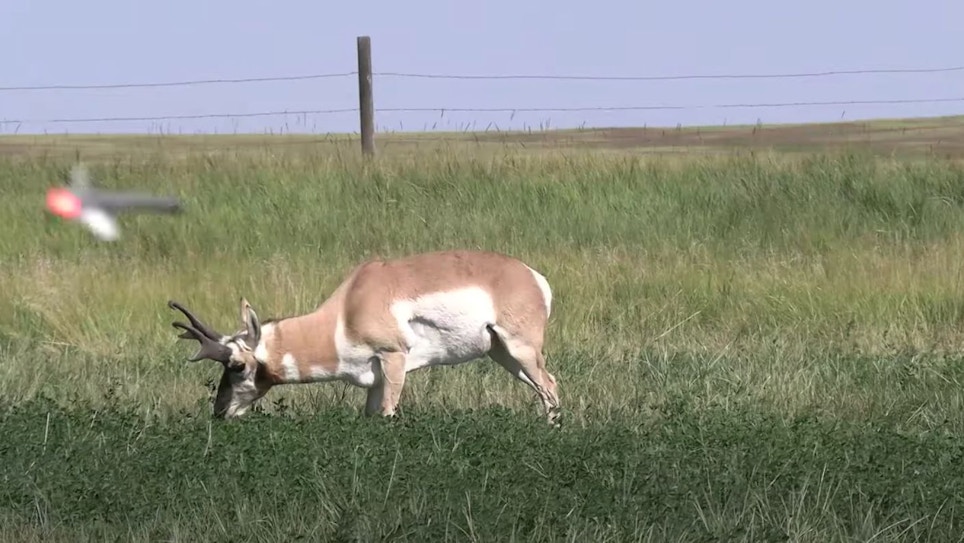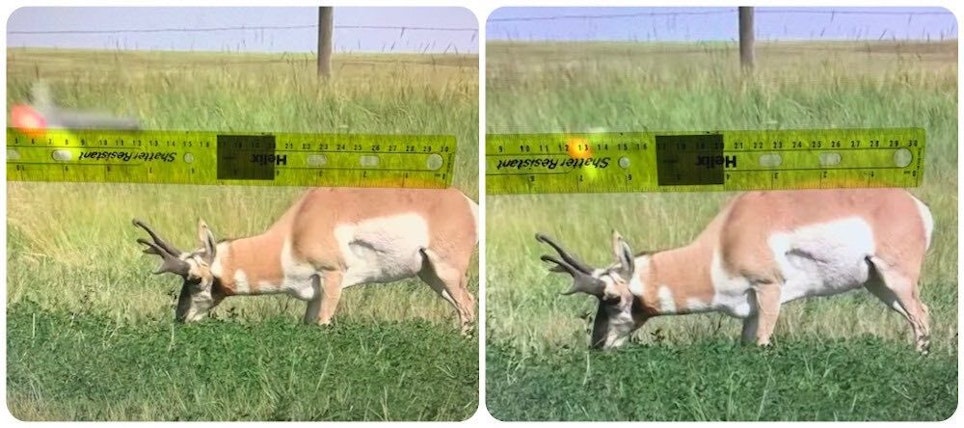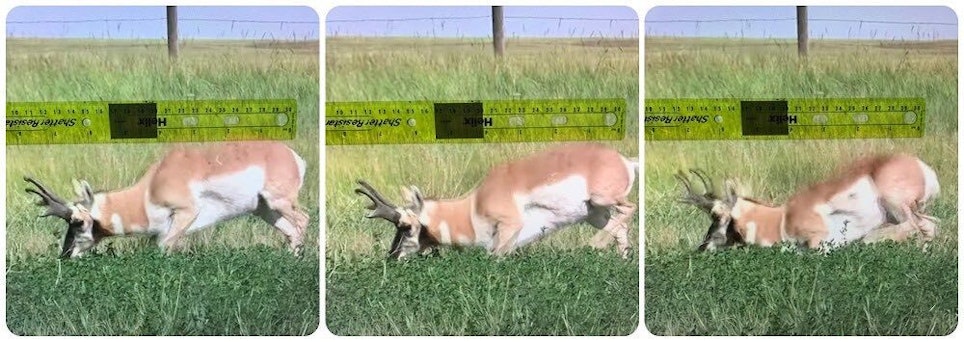In the 15-minute video below, Lane Housner from the YouTube channel In the Presence travels across the country to visit Belle River Outfitters in South Dakota for his first pronghorn hunt.
If you’re short on time, fast-forward to the 6:24 mark to watch encounter No. 1 with a big buck. It’s feeding in an alfalfa field at about 40 yards. With video running at normal speed, I couldn’t tell whether his arrow hit the buck low or missed, but Housner provides a good slow-motion view of the arrow flight; check it out at the 7:49 mark. I’m a bit confused as to why the camera shakes upon the bow’s release. Perhaps his bow bumped the tripod or the camera itself during the shot sequence? It’s possible because it’s a tight fit in this box blind when trying to film and shoot through the same small window.
Encounter No. 2 with the same buck really gets rolling at the 10:50 mark. Notice how the buck crosses under the barbed-wire fence at a spot where the bottom strand has been lowered to the ground. Housner doesn’t discuss it, but I assume the outfitter altered the fence for this purpose; smart.
The buck eventually begins feeding very close to where it was during encounter No. 1; the range is about 40 yards. Again, with the video running at normal speed, it’s difficult to decipher exactly where Housner’s arrow hits, but you can tell it’s too far back. Moments later, the buck stops on the other side of the fence, and as Housner prepares for a follow-up shot from a different window, you can easily see the arrow’s entrance hole. While it appears to be paunch hit, or perhaps a liver hit, the buck suddenly expires, so Housner’s broadhead must of clipped the lungs. Who knows, maybe the broadhead deflected slightly forward off a rib, working in Housner’s favor. The buck was also spinning to its right; that might have helped, too. I have to think that if the arrow was 1 inch further back that it would’ve missed the lungs. Even as I type this and watch the video again, it’s hard for me to believe the arrow hit lungs, but there’s no denying the outcome.
What I find most interesting is shown in the five-image photo sequence below. During Housner’s miss (encounter No. 1), the buck never moves while the arrow is in flight. Not so during the second encounter.
In these five photos you’ll notice my see-through yellow ruler, which is pressed tightly against my computer screen to mark the buck’s exact position during the shot sequence. Specifically, I wanted to mark the buck’s backline at the point right above the buck’s near front leg.
In the left photo above, you can see Housner’s arrow early in flight. The buck is relaxed and feeding. Note the position of the buck’s straight legs. I have my ruler positioned exactly where brown hide meets green grass, right over the buck’s near front leg. In the right photo, the arrow has traveled a bit closer to the animal (you can see the vanes behind my ruler); the buck hasn’t moved a muscle — yet.
Okay, here’s where things get interesting. In the left photo above, the buck is still feeding, but he’s no longer relaxed. Check out the position of the buck’s near front leg; it is no longer straight. He’s bending it to drop toward the ground to flee. Is he trying to duck the arrow? No. He simply hears something strange (the bow firing) and wants to run. This photo also shows the buck raising his near back leg for the same reason. Just these slight movements have caused the buck’s backline to drop slightly, one or two inches. You can now see a bit of green under my ruler (directly in line below the wooden post). Look very closely and you can see the vanes; mid body, well above the white hair line.
Now examine the center photo. The arrow has yet to strike the buck. The vanes are harder to see; they are mid body, and just an inch or two above the white hair line. The buck is a blur because he’s moving fast — downward. His front leg is already flexed to run and his back leg is catching up; it’s actually off the ground as the buck attempts to drop as fast as possible to get into a position to run. Look at the amount of green under my ruler. In the blink of an eye (from the left to center photos), the buck has dropped another 4 or 5 inches.
Finally, check out the right photo, which shows arrow impact. You can clearly see the vanes against the white hair. The buck’s chest is almost on the ground, and he’s spinning to his right. He’s ready to push hard off the ground with his front legs, then bring his back legs into action immediately. Look at the vast amount of green under my ruler! If I had to guess, I’d say the buck has dropped at least 8 inches total, maybe 10-12 inches.
Consider where Housner’s arrow would have hit if the buck didn’t react to the bow firing; i.e. if it hadn’t jumped the string. The arrow certainly would’ve missed the lungs; it likely would have been a low hit in the paunch.
Is there a lesson to be learned? During both of these close encounters, Housner is aiming at a relaxed animal, which is good. Of course, the buck might have been more cautious and on edge with its second visit to the alfalfa simply due to the first experience (hearing the bow fire, plus having a strange object tear through the vegetation beneath its belly).
I do think this scenario is a good reminder about maximum shot distance and animal size. I often hear from bowhunters who have a maximum shooting distance of X yards at whitetails, and distance Y on pronghorns, and Y is a bigger number than X. That makes no sense to me. A big whitetail buck’s heart/lung area is larger than that of a big pronghorn buck’s vitals. In other words, the bull’s-eye/target is literally larger on a whitetail.
In my humble opinion, if your maximum range on a whitetail is 40 yards, then there’s no way your maximum range on a pronghorn should be 45 or 50. Instead, your maximum range on a pronghorn should be 35-ish. Of course, when it comes to western species such as elk, which are much larger than whitetails, it makes sense to have a longer maximum range because the target (heart/lung area) is bigger.








